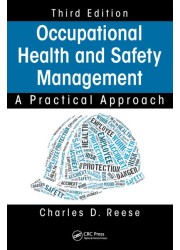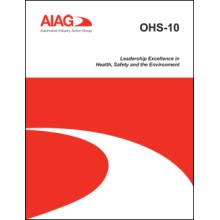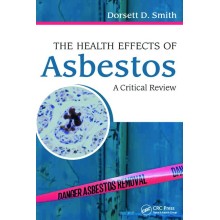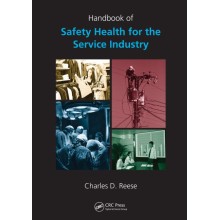Occupational Health and Safety Management: A Practical Approach, Third Edition
Our Price: £73.80
Discount : 10%
Quantity:
-
Add to Compare
Reflecting changes in the current health and safety landscape, Occupational Health and Safety Management: A Practical Approach, Third Edition includes examples and tools to facilitate development and implementation of a safety and health management approach. This how-to book is not just an information providing text. It shows you how to write a program and identify hazards as well as involve workers and attain their cooperation. It emphasizes the need for better and more effective communication regarding safety and health.
See What’s New in the Third Edition:
- Chapters on workers’ compensation, terrorism, and Lean safety/sustainability
- Additional coverage of flammable liquids and ventilation, accident reporting, and accident investigation
- New compliance requirements as well as expanded accident investigation, environmental, and risk analysis guidelines
- PowerPoint presentation slides for each chapter
A complete and practical guide for the development and management of occupational safety and health programs in any industry setting, the book supplies a management blueprint that can be used for occupational safety and health in any organization, from the smallest to the largest, beginning to develop or wanting to improve its safety and health approach. It includes comprehensive guidelines for development of occupational health and safety programs to a variety of industries and is especially useful for start-up companies.
The author takes a total management approach to the development of written programs, the identification of hazards, the mitigation of hazards by the use of common safety and health tools, the development of a safe workforce through communications, motivational techniques, involvement, and training. He addresses the tracking and acceptable risk from both safety and health hazards. He also discusses how to work with and within the OSHA compliance approach as well as how to deal with the OSHA regulations, workers’ compensation, terrorism, and Lean safety. As you understand and apply the guidelines in each chapter, you can put your company on the way toward building a successful and effective safety and health effort for its employers and employees.
Table of Contents
In the Beginning: Introduction
History
Numbers
True Bottom Line
Content
Bibliography
Making a Commitment: Management’s Commitment and Involvement
Management’s Commitment and Involvement
Roles and Responsibilities
Responsibility
Discipline
Management Accountability
Supervisory Accountability
Bibliography
Being a Part: Workforce Involvement
Involvement
Joint Labor/Management Safety and Health Committees
Policy Establishing Joint Committees
Bibliography
Put It in Writing: A Written Safety and Health Program
Reasons for a Comprehensive Safety Program
Building a Safety and Health Program
Other Required Written Programs
Requirements and Elements of OSHA Guidelines for a Safety and Health Program
National Safety Council’s Elements of a Safety and Health Program
Emergency and Medical Planning
First Aid and Medical Availability
Emergency Procedures and Response
Bibliography
Getting Safe Performance: Motivating Safety and Health
Setting the Stage
Defining Motivation
Principles of Motivation
Motivational Environment
Self-Motivation
Needs Move Mountains and People
Motivational Leadership
Effects of Other Factors
Summary
Bibliography
How They Act: Behavior-Based Safety
Behavior-Based Safety
Heinrich’s Domino Concept
Behavior-Based Safety Today
Hindrances to Implementing BBS
Summary
Bibliography
New Approaches: Lean Safety and Sustainability
Benefits of Lean Approach
Challenges of Lean Safety
Changing Culture
Learning and Training
Lean Techniques and Tools
Standard Safety Tools
Sustainability
Summary
Bibliography
Search for the Culprits: Hazard Identification
Hazard Identification
Accident Types
Hazard Reporting System
Workplace Inspections or Audits
Accident Investigations
Bibliography
Taking a Serious Look: Analyzing Hazards
Hazard Analysis
Root Cause Analysis
Change Analysis
Job Hazard Analysis
Analyzing Accident Data
Risk versus Cost
Bibliography
Hurting: Occupational Injuries
Bureau of Labor Statistics
Occupational Trauma Deaths
Occupational Injuries
Injury and Death Cost
Bibliography
Sick: Occupational Illnesses
Identifying Health Hazards
Temperature Extremes
Ionizing Radiation
Noise-Induced Hearing Loss
Nonionizing Radiation
Vibration
Health Hazards
Hazardous Chemicals
Biological Monitoring
Flammable and Combustible Liquids
Hazard Communications Standard
Bibliography
Bent Too Far: Ergonomics
Ergonomics
Extent of the Problem
Developing an Ergonomic Program
Ergonomic Risk Factors
Physical Work Activities and Conditions
Limits of Exposure
Ergonomic Controls
Tracking Progress
Proactive Ergonomics
Education and Training
Bibliography
Addressing Illnesses: Industrial Hygiene
Introduction to Occupational Illness Prevention
Industrial Hygienist
Environmental Factors or Stressors
Modes of Entry for Contaminants
Types of Air Contaminants
Exposure Monitoring
Units of Concentration
Exposure Guidelines
When You Need an Industrial Hygienist
Bibliography
Taking Action: Intervention, Controls, and Prevention
Hazard Prevention and Controls
Elimination or Substitution
Engineering Controls
Awareness Devices
Work Practices
Administrative Controls
Personal Protective Equipment
Ranking Hazard Controls
Other Tools That Can Be Used for Hazard Control
Hazard Control Summary
Bibliography
Using the Tools: Accident Prevention Techniques
Safety and Health Audits
Safety Talks and Meetings
Accident Investigations
Job Hazard Analysis
Safe Operating Procedures
Job Safety Observation
Fleet Safety Program
Preventive Maintenance Program
Special Emphasis Program
Using Safety and Health Consultants
Bibliography
Who Knows What: Safety and Health Training
Training and Education
When to Train
OSHA Training Model
Education/Training and Technology
Training New Hires
Training Managers
Training Supervisors
Training Employees
Training
Bibliography
Guiding Light: OSHA Compliance
OSHA Standards
Protections under the OSHAct
National Institute for Occupational Safety and Health
Occupational Safety and Health Review Commission
Employer Responsibilities under the OSHAct
Workers’ Rights and Responsibilities under the OSHAct
Discrimination against Workers
Right to Information
Aßuring a Safe and Healthy Workplace
Workers’ Complaints
OSHA Inspections
Workers’ Complaints and Requests for Inspections
Citations, Penalties, and Other Enforcement Measures
Common Issued Violations Found by OSHA
Most Frequent Violations Cited by OSHA for All Industries
State OSHA Plans
Worker Training
Occupational Injuries and Illneßes
Medical and Exposure Records
Posting
What to Do When OSHA Comes Knocking
Multiemployer Worksites
Summary
Bibliography
Golden Rules: OSHA Regulations
Federal Laws
OSHAct
Content of the OSHAct
Regulatory Process
Federal Register
Code of Federal Regulations
Regulation Paragraph Numbering System
Bibliography
A Helping Hand: Workers’ Compensation
Employer Liability
Exclusive Remedy
Covered Events
Selecting a Physician
Benefits
Survivor Benefits
Rehabilitation
Administration
Second Injury Funds
Risk and Insurance
Loss Control
Injury Management Programs
Summary
Bibliography
All Around: Workplace Environmental Issues
Industry Today
Introduction to Laws and Regulations
Industry's Dilemma
Describing the Major Issues Faced
Major Environmental Laws
Further Planning and Action
Bibliography
Keep Me Safe: Workplace Security and Violence
Workplace Violence Statistics
Risk Factors
Prevention Strategies
Cost of Violence
Prevention Efforts
Program Development and Essential Elements
Types of Workplace Violence Events
Summary
Bibliography
Mean Ones: Workplace Bullying
Bullying
Summary
Bibliography
External Forces: Terrorism
Travel Security
Suggested Antiterrorism Security Measures
Potential Terrorist’s Weapons
Summary
Bibliography
Let Us Find a Way: Safety Communications
The Communicator
Safety Culture
Communication Tools
Summary
Bibliography
Everything Costs Dollars: Budgeting for Safety and Health
Budget Items
Budget Approach
Compliance Factor
Written Budget
Controlling Cost
Summary
Bibliography
All’s Well That Ends Well: Summary
Ethics of the Occupational Safety and Health Profession
Principles of Management Today
Taking Another Look
Five Principles for Safety and Health
Supervisor’s 10 Commandments of Safety and Health
Ten Commandments of Safety and Health for Your Workforce
Bibliography
A: Emergency Action Plan--Fire Evacuation
Emergency Telephone Numbers
B: Written Safety and Health Program
Management’s Commitment
Aßigning Responsibility
Safety and Health Policy Statement
Company Safety Goals and Objectives
Safety Enforcement Policy
Management Officials
Supervisors
Employees
Competent/Qualified Persons
Monthly Project or Production Safety Meeting
New-Hire Safety Orientation
Supervisor Training
Safety Bulletin Board
Safety Talks
OSHA Records
Medical/Exposure Records
Training Records
First-Aid Supplies
Medical Services
Worksite First-Aid Log
Emergency Procedures
Summary
Hazard Identification Tool
Electrical
Machines and Equipment
Hand Tools
Confined Spaces
Elevated Work Areas
Welding and Cutting
Toxic or Hazardous Chemicals
Radiation
Radioactive Materials
Nonionizing Radiation
Lasers
Explosives
Thermal
Pressure
Noise
Other Hazards
Biological
Ergonomics
Temperature Extremes
More Hazards
Environmental
Controls
Other Systems
Safety and Health Audit Instrument
Contents
E: Sample and Blank Material Safety Data Sheets
F: Ergonomics Solution Chart
G: OSHA Safety and Health Training Requirements
General Industry Training Requirements (29 CFR Part 1910)
Shipyard Employment Training Requirements (29 CFR Part 1915)
Marine Terminal Training Requirements (29 CFR Part 1917)
Longshoring Training Requirements (29 CFR Part 1918)
Construction Industry Training Requirements (29 CFR Part 1926)
Agriculture Training Requirements (29 CFR 1938)
Federal Employee Training Requirements (29 CFR Part 1960)
H: OSHA Offices
Regional Offices
State Plan Offices
50 Most Cited Violations by Major Industrial Groups
Division A: Agriculture, Forestry, and Fishing (1-9)
Division B: Mining
Division C: Construction (SIC 15-17)
Division D: Manufacturing (SIC 20-39)
Division E: Transportation, Communications, Electric, Gas, and Sanitary Services (SIC 40-49)
Division F: Wholesale Trade (SIC 50-51)
Division G: Retail Trade (SIC 52-59)
Division H: Finance, Insurance, and Real Estate (SIC 60-67)
Division I: Services (SIC 70-80)
Division J: Public Administration (SIC 91-99)
J: Summary of 29 CFR
Occupational Safety and Health Standards for the General Industry
K: CFR Titles
Most Common Air Pollutants and Toxic Chemicals
Ozone (Ground-Level Ozone Is the Principal Component of Smog)
VOCs: Smog Formers
Carbon Monoxide
Particulate Matter (PM-10) (Dust, Smoke, Soot)
Sulfur Dioxide
Lead
Toxic Chemicals
Workplace Security Program
Responsibility
Compliance
Communication
Hazard Aßeßment
Incident Investigations
Hazard Correction
Training and Instruction
N: Occupational Safety and Health Resources
Accident/Hazard Analysis
Accident Investigation
Accident Prevention
Construction Safety and Health
Consultants
Environmental
Ergonomics
Fleet Safety
Hazard Identification
Health Hazards
Industrial Hygiene
Job Hazard Analysis
Job Safety Observation
Lean Safety
Office Safety and Health
OSHA Compliance
Psychology of Safety
Regulations
Safety Hazards
Safety and Health Hazards
Safety and Health Management
Service Industry Safety and Health
System Safety
Training
Workplace Violence
Profeßional Organizations and Agencies
Health and Environmental Assistance
Safety and Engineering Consensus Standards
Professional Safety Organizations
Specialty Associations (with Specific Expertise)
Federal Government Sources
Electronic Sources (Internet)
Write a review
Your Name:Your Review: Note: HTML is not translated!
Rating: Bad Good
Enter the code in the box below:
Copyright © 2014 Engineering Standards Bureau. All Rights Reserved.
Developed By Zoom Into Web






